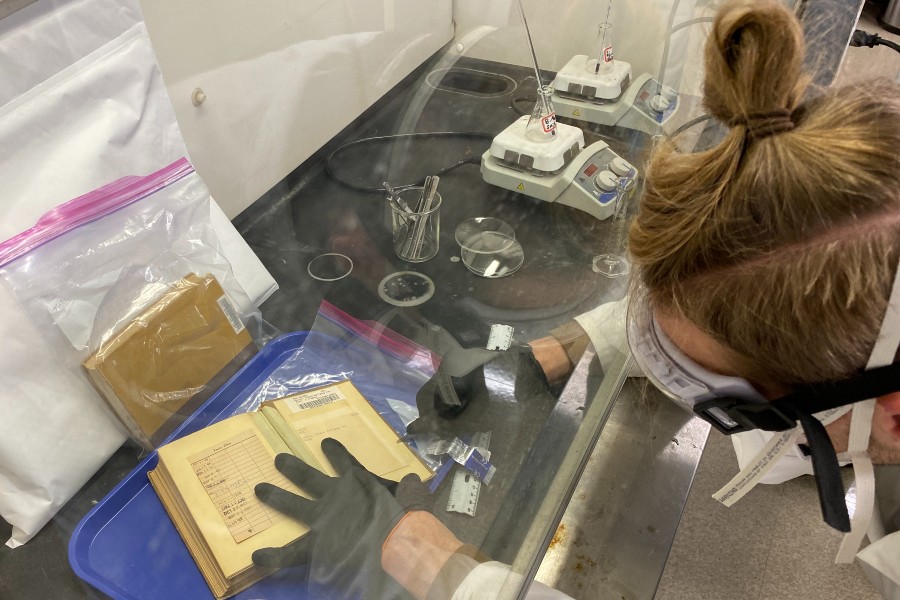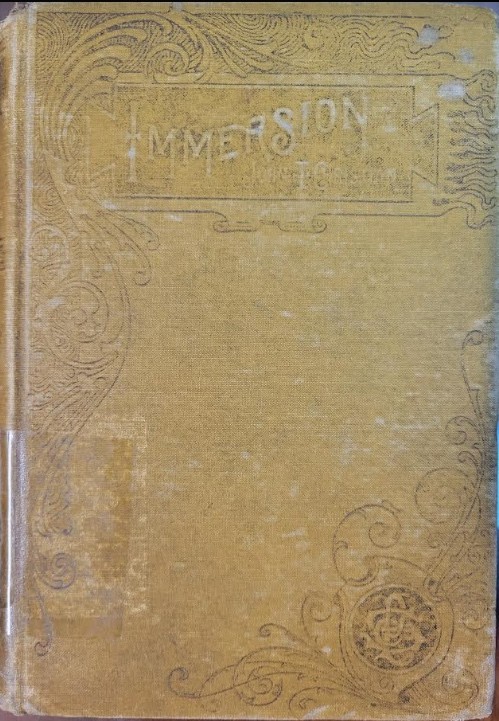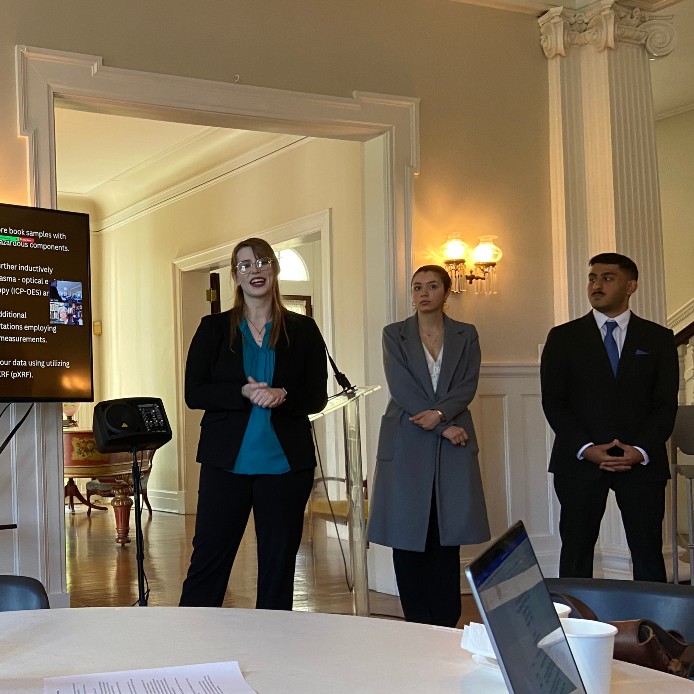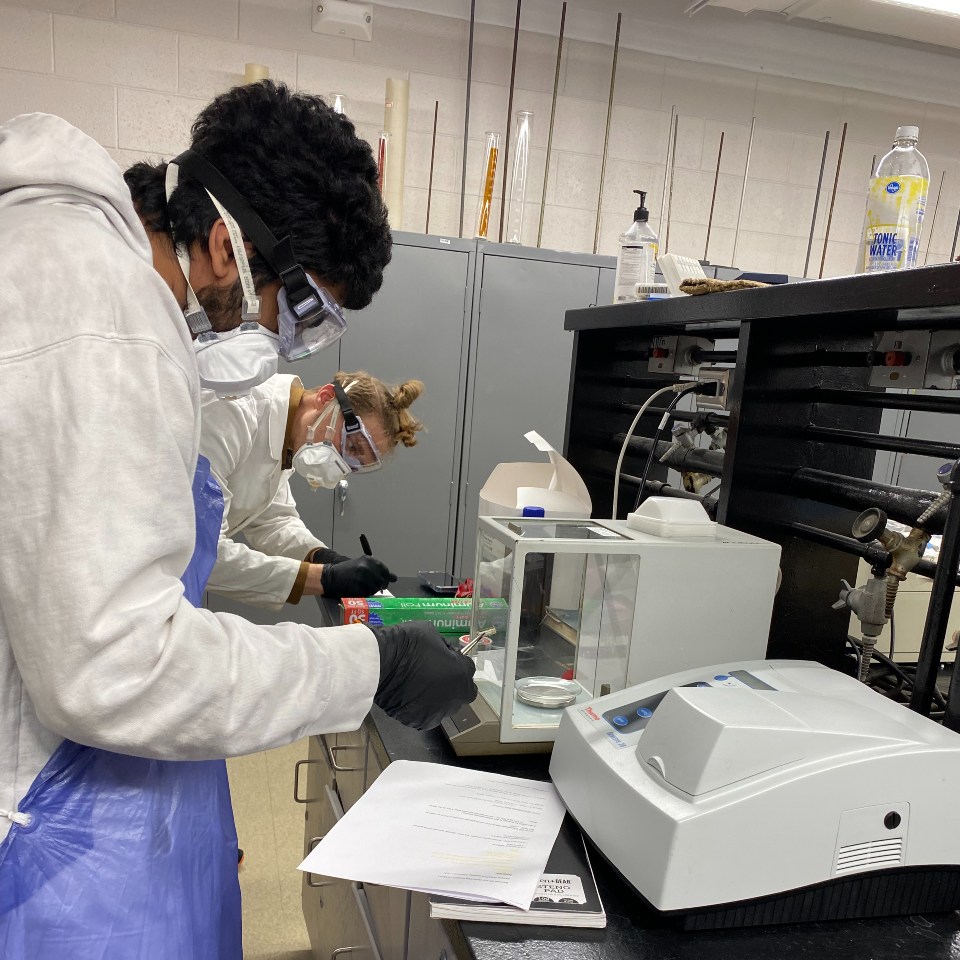Lipscomb contributes to the worldwide Poison Book Project
Undergraduate researchers discover toxic dyes on the covers of Victorian-era books.
Keely Hagan | 615-966-6491 |

Arsenic is widely known today as a poison that is fatal to humans. Yet, in the 19th century it was extensively used in numerous household items, including toxic dyes, which book publishers favored for their vivid hues.
Because the Beaman Library collection includes books that were published between 1800-1920 when toxic dyes were widely used, systems librarian Jan Cohu suspected that some of the books should be tested and contacted the chemistry department for help.
Cohu was inspired by the Poison Book Project, a national initiative launched by the Winterthur Library in Delaware that asks libraries worldwide to contribute to a better understanding of the toxic pigments used in 19th century book bindings.

Popular 19th Century book from the Beaman Library Collection
“The project made a splash in the library world,” Cohu says. “They were presenting findings in arsenical books, which are a bright green color from copper acetoarsenite. The Winterthur library collection is very different from ours, but I was curious about whether anything they had learned would apply to our library. We do have a lot of 19th century books.”
When Joseph Weinstein-Webb, assistant professor of chemistry, heard about Cohu’s request, he agreed to help and over the summer developed a method of testing book bindings where results can be confirmed using multiple modalities. When classes began in fall 2022, students delved into the testing process, beginning with nine books chosen by the library. A second set of eight was then selected for testing the following year.
“One of the first ones I pulled actually looked very much like the ones Winterthur suggested and tests confirmed that it did contain toxic dye,” says Beaman electronic resources librarian Michaela Rutledge. “We were off to a great start.”
The results confirmed concentrations of lead and chromium in the yellow pigment on five books, Adam Smith’s Essays, Christian Immersion, Sketches from English History, Mark Twain and the Happy Island and Mohun. These results correspond to the original hypotheses suggesting the presence of the highly toxic chromium yellow pigment which has potential health risks for those in contact with it. The initial analysis would indicate none of the tested samples contained any significant levels of arsenic, but further study is required.
This insight into book bindings being harmful to people is not something that is very widely known, which is what we're hoping to change. — Abigail Hoermann, junior
The research focuses on identifying potentially toxic pigments used in bookbinding components and how to handle and store potentially toxic collections using a safer protocol.
“We definitely won’t be putting anything with lead chromate back on the shelves,” says Cohu. “The book is removed from circulation, which isn’t much of a loss—there’s not a long waiting list for the titles that are a part of this initiative. But since they’re part of our collection, they do need to be tested.”
The poisonous qualities of these books were detected utilizing X-ray fluorescence analyses (XRF) and Inductively Coupled Plasma Optical Emission Spectroscopy (ICP-OES) instrumentation. Weinstein-Webb noted that XRF technology is widely used within the field of archaeology due to its non-destructive capacities. This spectroscopic tool hints to the potential for collaborations with the Lanier Center for Archaeology that would further expand the scope of research opportunities for chemistry students, exposing them to doctoral level work.

ABIGAIL HOERMANN, LEILA AIS, JAFER ALJORANI PRESENTING TO TTLA
The impact of this initiative has been showcased at various academic platforms, including poster presentations at the 2023 and 2024 Students Scholar Symposium (where students won outstanding presenter honors both years) and presentations at the Tennessee Theological Librarians Association. Students researchers working and presenting on the Poison Book Project at Lipscomb University with Weinstein-Webb this academic year are juniors Leila Ais and Abigail Hoermann, and senior Jafer Aljorani.
Additionally, Ais was awarded a Carruth research fellowship for summer 2024 study. There is also potential participation in the American Chemical Society Conference in the fall of 2024, says Weinstein-Webb.
“This insight into book bindings being harmful to people is not something that is very widely known, which is what we're hoping to change,” says Hoermann, who has worked as teaching assistant to Weinstein-Webb and has helped in the chemistry lab for two years.
When Cohu and Rutledge presented at the 2024 Tennessee Library Association Conference this spring, a large audience of librarians from across the state were in attendance, intrigued to learn more and how these methods would apply to them, Cohu says. “They felt like we were giving them something of incredible value.”
The initiative at Lipscomb has contributed to the larger Winterthur Project, where they have mainly focused on testing for the toxic pigment emerald green. The books tested in the Beaman Library have mainly focused on chrome yellow pigment and have provided important data about elevated levels of lead and chromium.
Weinstein-Webb explains that the research begins with hands-on benchwork, where students gain practical experience in lab techniques, including the safe handling of hazardous materials and the use of personal protective equipment. They conduct experimentation using spectroscopic instruments followed by data analysis software to determine presence of metal. Students are exposed to various aspects of experimental design, workflow management and the preparation of standards.

Weinstein-Webb, Jafer Aljorani lab research
“Beyond the technical aspects of research, this initiative fosters the development of critical thinking, autonomy, and independence among students,” Weinstein-Webb says. “These skills are crucial for pursuing advanced degrees and vital in fields such as medicine and dentistry.
“This initiative aligns seamlessly with Lipscomb’s strategic goals and core curriculum, emphasizing critical thinking, public speaking, and writing skills,” he says. “Students learn to identify research problems, formulate hypotheses, design experiments and analyze results.”
Weinstein-Webb says he is exploring more initiatives like this one that can serve as a testament to the power of curiosity, collaboration, and commitment to fostering scientific inquiry and skill development among students. It exemplifies the university’s strategic goal of empowering the next generation of scientists and scholars through research productivity, preparing them for successful careers and meaningful contributions to their respective fields.